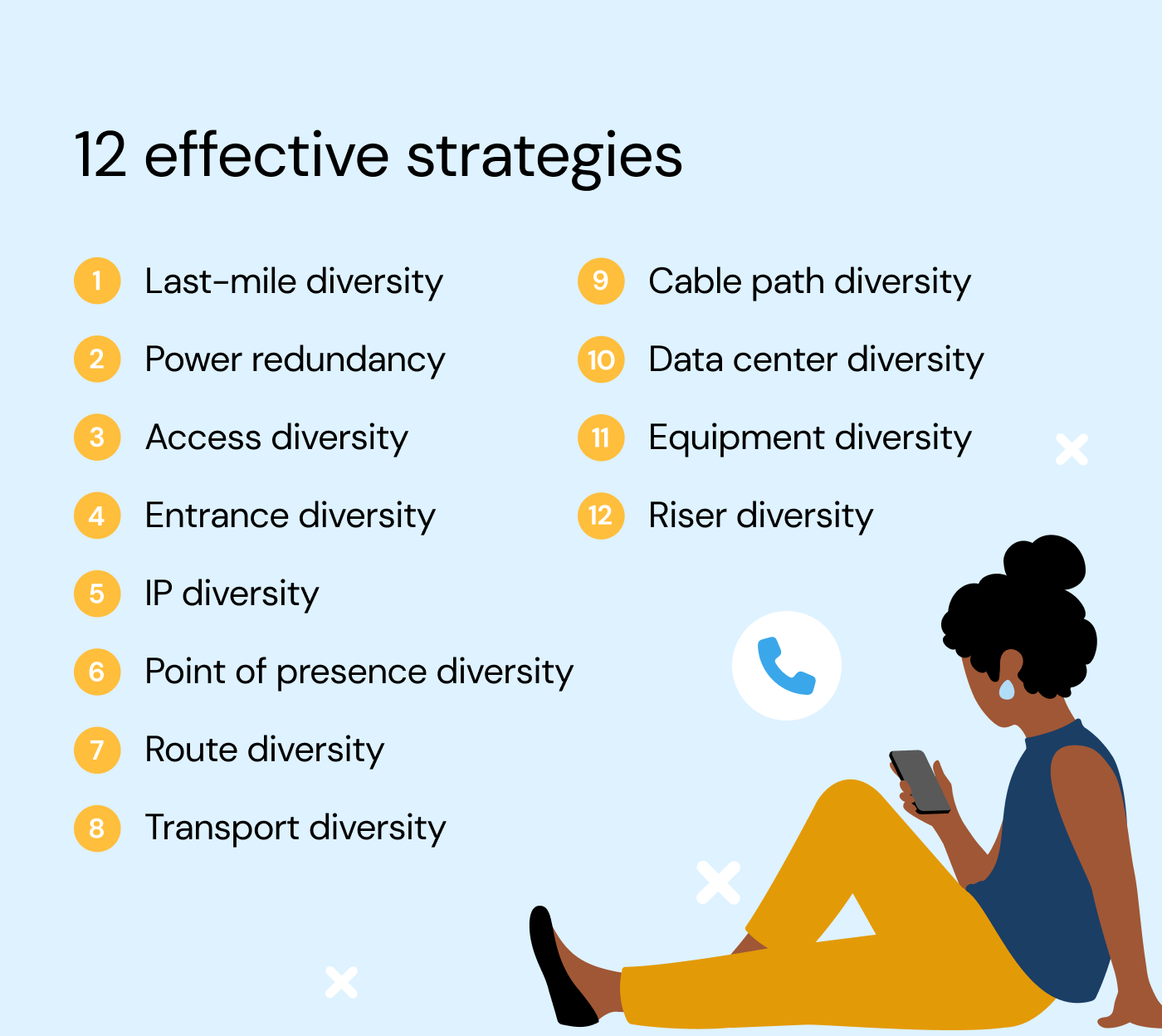Insights
Network diversity: 12 effective strategies

Insights

Network downtime is an operational nightmare for any business and directly hits the bottom line. Network diversity is a rigorous solution for all organizations aiming to safeguard against service interruptions and ensure continuous communication is available.
One survey uncovered the average cost per hour of enterprise service downtime ranges from $50,000 to $5 million, with 25% of organizations indicating $300,000 to $400,000 in hourly costs from downtime. While this survey considers all IT (Information Technology) services, if your teams can’t communicate, the fiscal impact on your organization will be significant.
How can you minimize these costs and ensure telecom services remain available? Network diversity is rapidly becoming the answer for many businesses.
Network diversity allows organizations to minimize or mitigate the effects of any downtime throughout the network and is chiefly concerned with ensuring the continuity of telecommunications.
Service downtime can be caused by multiple events from a rodent chewing on the wrong wire to a sophisticated cyber-attack. Networks employing diversification strategies are significantly more resilient to the range of disruptions possible throughout the infrastructure.
Over a dozen strategies are involved in achieving true network diversity, however many businesses focus only on carrier diversity. Yet carrier diversity is often confused with network diversity, but it’s actually one of the least effective ways to keep your communications operational.
What exactly is a carrier? In the world of telecom, terms like carrier, telco, telecommunications, or telecom service provider are generic or catch-all phrases and are frequently used interchangeably for entities providing any type of telecommunications service.
Services from a carrier often include mobile, voice, and data as their primary line of business to consumers, enterprises, governments, and even other telecom service providers.
A carrier network is a proprietary network infrastructure belonging to a telecommunications service provider. Carrier networks comprise large and complex hardware configurations, interconnected to provide communications services to customers across a far-reaching area. Regulatory agencies authorize these carriers to operate the telecommunications systems.
It’s common for carriers to resell or deliver services on the same infrastructure and facilities as the other carriers.
Businesses are often told carrier diversity is the only way to ensure their telecoms remain intact. However, since many carriers already rely on the same networks, this network diversity strategy is inherently flawed.
Signing up with multiple carriers results in having to manage several different telecom companies and receiving multiple bills from all involved carriers. And there is a good chance they’re using the same network, which is susceptible to the same outages and affects all services.
Another issue with this strategy is porting your telephone numbers to migrate services to another carrier.
Porting numbers is not a fast task, and the more numbers you need to move, the longer it will take. Additionally, the outage you’re trying to work around may be resolved before the porting is done.
So, let’s explore core network diversification strategies, each striving to keep your business moving in the face of possible disruptions.

Let’s dive into core network diversification strategies, each a shield against potential disruptions, ensuring your business sails smoothly through stormy weather.
Last-mile diversity is about ensuring the local loops of two circuits being delivered to the exact location are routed through two separate network facilities.
This way should an outage occur at one of these facilities, traffic can simply route through another facility and keep services operational, likely without any interruption impacting users.
Network services rely on the local power grid, making power outages a common cause of network downtime. Implementing backup batteries and on-premises generators is a reliable way to improve resilience to power outages and allow the carrier to implement other strategies should the power remain down for an extended period.
Like other network diversity strategies, the end-user may never know the issue occurred when adequately implemented.
Access diversification creates backup for the local access circuits, connecting you to the service provider’s central hub, ensuring you are not relying solely on one route to a local access circuit.
Network diversity strategies aren’t always about what happens outside of your building but often how your facilities connect to the network.
Entrance diversity is concerned with your on-premises access to the network circuit. If you rely solely on one entrance method, you may experience downtime at the entire location.
The telecommunications service obligations (TSO) call for ensuring multiple entrances to your premises. So, for example, if you have a circuit entering on the west end of the building, another circuit can be installed to enter through the south end.
Have you reviewed your current entrance points to ensure you’re protected from a single point of failure? Implementing several entrance points is essential to create a more redundant service.
IP addresses are allocated in blocks to different service providers. As such, IP diversity provides you with IP addresses from different blocks and providers.
This strategy results in a second option for routing Internet services if a circuit goes down. IP addresses can be updated to leverage another network instead of porting numbers or otherwise switching to another carrier entirely.
Circuits originating from different points of presence (POPs) add a layer of network diversity and protection against downtime by providing different routes to the building. For example, if one goes down, a network with POP diversity can route traffic through another POP.
Additionally, it’s common for diverse POPs to have different physical routes to the building, which are at least partially diverse.
This type of diversity focuses on network architecture, ensuring a customer’s traffic takes two or more separate paths from origination to destination. Route diversity is often used for private line services, which receive additional engineering attention to ensure uptime.
Transport diversity provides alternative transmission paths in the connection’s network core or cross-market section. This type of network diversity takes a high-level view of network transmissions and finds opportunities to create redundant paths in the event of an outage anywhere in the network.
Your building receives internet and telecom services through cables entering your building. Cable path diversity calls for separate runs of CAT 5, 6, and 7 or fiber optic cables, often in combinations, entering the building using different conduits than the primary cable entrance.
This type of diversity is like entrance diversity, with a stronger focus on several types of cables.

Routing identical data streams to geographically separate data centers creates a level of redundancy for duplicate processing and storage. Should one data center experience an outage, alternative data centers are ready to take over with no or minimal end-user disruption.
Like entrance and cable diversity, equipment diversity is another strategy focusing on the on-premises connection. Switches and hardware for a secondary or tertiary connection are housed in a separate closet or another building from the primary connection.
Riser diversity calls for running secondary or tertiary fiber and cable lines inside the building to the server racks in a separate duct as the primary service connection. This strategy is similar to cable path and entrance diversity but focuses on how lines run throughout the facility.
Separating these connections ensures scenarios like flooding or a rodent chewing through cables do not affect backup connections.
Carrier diversity is mistakenly considered an effective option to keep your communications operational. Yet, you start to see the problems with this strategy when considering how long porting enterprise numbers will take, and many carriers are using the same infrastructure.
Instead of taking on a new monthly expense, effective network diversity is achieved by choosing the right carrier.
The right carrier leverages the above strategies to provide telecom services already resilient to going down, keeping your business operational. Ask any potential carrier the right questions so you fully understand their infrastructure before signing up.
Sinch employs robust strategies to diversify our telecom networks, so our customers experience the least disruption possible — it’s how we’ve earned our 99.999% uptime rating. On top of what we explored above, we have comprehensive monitoring and alert systems to correct any issues before they impact our users.
Ready to embrace network diversity without taking on a new bill or the hassle of managing multiple telecom providers? Contact Sinch today to talk to a telecom expert and learn how we keep your services operational.
